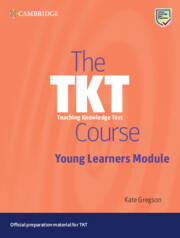Book contents
- Frontmatter
- Acknowledgements
- Contents
- Introduction
- Part 1 Knowledge of young learners and principles of teaching English to young learners
- Part 2 Planning and preparing young learner lessons
- Part 3 Teaching young learners
- Part 4 Assessing young learner learning in the classroom
- Follow-up activities: Answer keys and commentaries
- List of terms found in the TKT Glossary
- Glossary of TKT: Young Learners terms
- Test tips for TKT: Young Learners
- Teaching knowledge test young learners: Practice test
- Sample test answer sheet for TKT: YL practice test
- Answer key for TKT: YL practice test
Unit 6 - Classroom materials: How can I challenge and support children’s learning when I select and use classroom materials?
Published online by Cambridge University Press: 14 March 2024
- Frontmatter
- Acknowledgements
- Contents
- Introduction
- Part 1 Knowledge of young learners and principles of teaching English to young learners
- Part 2 Planning and preparing young learner lessons
- Part 3 Teaching young learners
- Part 4 Assessing young learner learning in the classroom
- Follow-up activities: Answer keys and commentaries
- List of terms found in the TKT Glossary
- Glossary of TKT: Young Learners terms
- Test tips for TKT: Young Learners
- Teaching knowledge test young learners: Practice test
- Sample test answer sheet for TKT: YL practice test
- Answer key for TKT: YL practice test
Summary
LEARNING OUTCOMES
By the end of this unit, you will…
KNOWLEDGE: know how to analyse materials for suitability to a group of children SKILLS: be able to find appropriate solutions to common problems with classroom materials
■ Starter Question
Before you begin this unit, read the starter question and make some notes. Then read the commentary and compare it to your notes.
What kinds of materials are you familiar with, or are available in your teaching context?
COMMENTARY
Learning materials are ‘anything which is used specifically with the intention of increasing pupils’ knowledge and experience of the language’ (Moon, 2000, p. 86); they come in many forms and use different media. They may be developed for language teaching and learning, or they may be designed for ‘real’ purposes. They are often tied to a curriculum or course syllabus, depending on the teaching context, but they may also be additional resources (see Unit 7).
Print-based teaching and learning materials
Courses often follow a coursebook (sometimes known as ‘textbook’), which may include different components such as a Student's Book and Workbook for the children to use, a Teacher's Book, which supports the teacher in lesson planning, and other multimedia resources such as classroom audio (e.g. on a CD or as web-based audio files), video (e.g. on a DVD, as web-based media files or streamed) and other webbased resources which children can use online or which teachers can download and print to use as handouts, flashcards or classroom posters to manage their classes. These kinds of coursebook packages can help a teacher provide a range of different language input and practice activities in a coherent way.
Teachers may also turn to sets of printed photocopiable resources, often for supplementary materials, which can be in the form of handouts, complete lessons or sequences of lessons. An example is ‘Primary Communication Box’ and others in this series of photocopiable resources for primary ELT from Cambridge University Press & Assessment.
Often these kinds of print-based materials are developed for a global market. They are usually written and produced by experienced teachers and writers, and are generally very appealing visually and of high quality.
- Type
- Chapter
- Information
- The TKT Course Young Learners Module , pp. 54 - 63Publisher: Cambridge University PressPrint publication year: 2024



